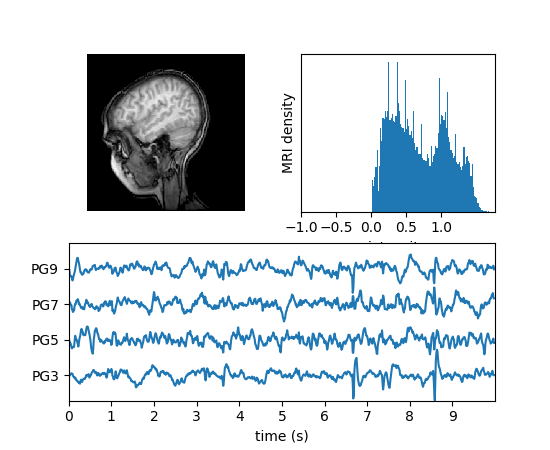
(Source code, png, pdf)

#!/usr/bin/env python
"""
This now uses the imshow command instead of pcolor which *is much
faster*
"""
from __future__ import division, print_function
import numpy as np
from matplotlib.pyplot import *
from matplotlib.collections import LineCollection
import matplotlib.cbook as cbook
# I use if 1 to break up the different regions of code visually
if 1: # load the data
# data are 256x256 16 bit integers
dfile = cbook.get_sample_data('s1045.ima.gz')
im = np.fromstring(dfile.read(), np.uint16).astype(float)
im.shape = 256, 256
if 1: # plot the MRI in pcolor
subplot(221)
imshow(im, cmap=cm.gray)
axis('off')
if 1: # plot the histogram of MRI intensity
subplot(222)
im = np.ravel(im)
im = im[np.nonzero(im)] # ignore the background
im = im/(2.0**15) # normalize
hist(im, 100)
xticks([-1, -.5, 0, .5, 1])
yticks([])
xlabel('intensity')
ylabel('MRI density')
if 1: # plot the EEG
# load the data
numSamples, numRows = 800, 4
eegfile = cbook.get_sample_data('eeg.dat', asfileobj=False)
print('loading eeg %s' % eegfile)
data = np.fromstring(open(eegfile, 'rb').read(), float)
data.shape = numSamples, numRows
t = 10.0 * np.arange(numSamples, dtype=float)/numSamples
ticklocs = []
ax = subplot(212)
xlim(0, 10)
xticks(np.arange(10))
dmin = data.min()
dmax = data.max()
dr = (dmax - dmin)*0.7 # Crowd them a bit.
y0 = dmin
y1 = (numRows - 1) * dr + dmax
ylim(y0, y1)
segs = []
for i in range(numRows):
segs.append(np.hstack((t[:, np.newaxis], data[:, i, np.newaxis])))
ticklocs.append(i*dr)
offsets = np.zeros((numRows, 2), dtype=float)
offsets[:, 1] = ticklocs
lines = LineCollection(segs, offsets=offsets,
transOffset=None,
)
ax.add_collection(lines)
# set the yticks to use axes coords on the y axis
ax.set_yticks(ticklocs)
ax.set_yticklabels(['PG3', 'PG5', 'PG7', 'PG9'])
xlabel('time (s)')
show()
Keywords: python, matplotlib, pylab, example, codex (see Search examples)